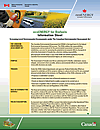Environmental Assessments
As the Responsible Authority (RA) for projects funded under this program, NRCan must ensure that an Environmental Assessment (EA) is carried out in accordance with the Canadian Environmental Assessment Act (CEAA) and must consider the EA findings before a decision is made to provide an incentive for a project.
The Canadian Environmental Assessment Act
The Canadian Environmental Assessment Act (CEAA) is the legal basis for the federal Environmental Assessment (EA) process. The CEAA outlines the responsibilities, requirements and procedures for the environmental assessment of projects and establishes a process for assessing the potential environmental effects of projects in which the Government of Canada has a decision-making responsibility.
All proponents should obtain a copy of the CEAA and related regulations from the Canadian Environmental Assessment Agency.
Purpose
The Government of Canada uses EA as a planning tool to identify, understand, assess, mitigate, and prevent where possible, adverse environmental effects of a project before irrevocable decisions are made.
Triggers
Under the CEAA, federal departments and agencies (Federal Authorities [FAs]) are required to undertake an EA for projects relating to a physical work and for any proposed physical activity listed in the Inclusion List Regulations of the CEAA whenever they:
- Propose or undertake a project;
- Grant money or any other form of financial assistance to a project;
- Grant an interest in federal land to enable a project to be carried out; or
- Exercise a regulatory duty in relation to a project, such as issuing a permit or license that is included in the Law List Regulations of the CEAA.
Role of ecoENERGY for Biofuels
The financial incentives provided under the ecoENERGY for Biofuels program triggers the need for a federal EA under the CEAA. Natural Resources Canada (NRCan) is the Responsible Authority (RA) for projects funded under this program and therefore must ensure that an EA is carried out in accordance with the CEAA and must consider the EA findings before a decision is made to provide an incentive for a project.
Project Description
A proponent must submit to NRCan a project description, based on the Operational Policy Statement on Preparing Project Descriptions under the CEAA (PDF, 354 Kb), which will be circulated to other federal departments in accordance with the Federal Coordination Regulations. This process will determine whether other federal departments or agencies also have a decision-making role (RA) or can provide expert advice (FA) on the project in question.
Environmental Impact Statement (EIS)
Most projects funded under the ecoENERGY for Biofuels program will require a screening level assessment, meaning that the proponent will have to provide an Environmental Impact Statement (EIS). The proponent’s EIS must be a stand-alone document that provides the RA(s) and the public with details of the proposed project, the existing environment and the interaction between the two. The EIS must be written with the general public in mind. The review of the EIS can be an iterative process; therefore a detailed EIS will likely reduce the need for additional information.
EA Decision
The RA(s) will review the final EIS and then write an Environmental Assessment Screening Report. The screening report will be based on the information provided in the EIS and on comments received from expert federal departments and the public. The RA’s EA determination will be included in the screening report.
Guidelines
Proponents should refer to the Environmental Assessment Guidelines for Screening Level Assessments of ethanol (PDF, 513 KB) and biodiesel (PDF, 481 KB) projects funded under the ecoAgriculture Biofuels Capital Initiative.
Proponents should follow the structure of these documents when writing an EIS.
Please note: A project that includes a component listed on the Comprehensive Study List Regulations would trigger a comprehensive study level assessment. Therefore, the above process would not apply.
Public Registry
A guiding principle of the CEAA is public participation. To help promote public participation, the RA(s) must establish a public registry for every project, in which information on the EA of the project is placed and made available to the public. However, confidential information disclosed through the EA process can be protected under the Access to Information Act. Protected information under this Act will not be disclosed to the public and thus would not be placed in the public registry.
Questions
The CEAA’s Web site provides answers to Frequently Asked Questions.
Page details
- Date modified:
